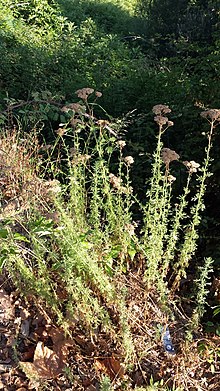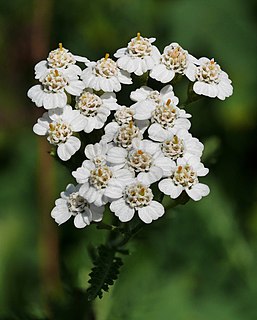
Achillea millefolium, commonly known as yarrow or common yarrow, is a flowering plant in the family Asteraceae. It is native to temperate regions of the Northern Hemisphere in Asia, Europe, and North America. It has been introduced as a feed for livestock in New Zealand and Australia, where it is a common weed of both wet and dry areas, such as roadsides, meadows, fields and coastal places.

Achillea is a group of flowering plants in the family Asteraceae, known colloquially as yarrows. They were described as a genus by Linnaeus in 1753. The genus was named after the Greek mythological character Achilles. According to legend, Achilles' soldiers used yarrow to treat their wounds, hence some of its common names such as allheal and bloodwort.
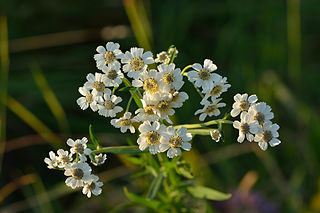
Achillea ptarmica is a European species of herbaceous perennial flowering plant in the genus Achillea of the daisy family Asteraceae. Common names include the sneezewort, sneezeweed, bastard pellitory, European pellitory, fair-maid-of-France, goose tongue, sneezewort yarrow, wild pellitory, and white tansy. It is widespread across most of Europe and naturalized in scattered places in North America. It is native to Europe and western Asia.

Dimorphotheca sinuata, the glandular Cape marigold, Namaqualand daisy, or orange Namaqualand daisy; syn. Dimorphotheca aurantiaca hort.) is an African species of plants native to southern Africa. It is also widely cultivated as an ornamental and naturalized in parts of the United States, primarily California and Arizona.

Achillea filipendulina, the yarrow, fernleaf yarrow, milfoil, or nosebleed, is an Asian species of flowering plant in the sunflower family, native to central and southwestern Asia. It is also naturalized in parts of Europe and North America.

Achillea nobilis, the noble yarrow, is a flowering plant in the sunflower family. It is native to Eurasia, widespread across most of Europe and also present in Turkey, the Caucasus, and Central Asia. It is reportedly present in Xinjiang Province in western China, but this is based on a single herbarium specimen collected in the 19th century. The species is widely cultivated and has become naturalized outside of its range in North America and other parts of the world.

Rumex hypogaeus, commonly known in English as southern threecornerjack, devil's thorn, or double gee, is a herbaceous plant of the Polygonaceae. It is native in South Africa and is an invasive species in Australia, Texas in the USA & Pakistan.

Spinulum annotinum, synonym Lycopodium annotinum, known as interrupted club-moss, or stiff clubmoss, is a species of clubmoss native to forests of the colder parts of North America, as well as Asia, and most of Europe. The genus Spinulum is accepted in the Pteridophyte Phylogeny Group classification of 2016, but not in other classifications, which submerge the genus in Lycopodium.
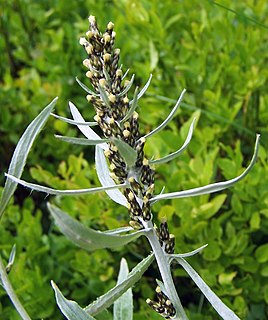
Gnaphalium norvegicum, the highland cudweed or Norwegian arctic cudweed, is a European species of plants in the sunflower family. It is widespread across much of Europe from the Mediterranean north to Finland and Iceland.

Achillea ageratum, also known as sweet yarrow, sweet-Nancy, English mace or sweet maudlin, is a flowering plant in the sunflower family, native to Europe, and Morocco. In the United States the plant is cultivated in the state of New York for its pleasant fragrance and sparingly naturalized in a few places outside its native range.

Achillea atrata, commonly called black yarrow or dark stemmed sneezewort, is European species of herbaceous perennial flowering plant native to the Alpine regions of Switzerland, France, Italy, Germany, Austria, and Slovenia.
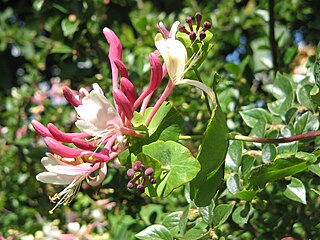
Lonicera caprifolium, the Italian woodbine, perfoliate honeysuckle, goat-leaf honeysuckle, Italian honeysuckle, or perfoliate woodbine, is a species of perennial flowering plants in the genus Lonicera of the family Caprifoliaceae. It is native to parts of Europe, and naturalised in South East Britain and northeastern North America. It can readily be distinguished from Europe's most common species, Lonicera periclymenum, by its topmost leaves, which are perfoliate as the Latin name suggests. It is a vigorous, deciduous climber growing up to 8 metres. It bears masses of very fragrant, cream-coloured flowers, tinged with pink, appearing in midsummer.

Dittrichia graveolens, commonly known as stinkwort or stinking fleabane, is a plant species in the sunflower family, native to southern Europe, North Africa, and western Asia as far east as Pakistan. It has become naturalized in California, Asia, Africa, Australia, and other places and is regarded as a noxious weed in some regions. It is a classified as an invasive species in California, and a potential threat to wine production in the state.

Achillea alpina, commonly known as alpine yarrow, Chinese yarrow or Siberian yarrow, is an Asian and North American species of plant in the sunflower family. It is native to Siberia, the Russian Far East, China, Mongolia, Korea, Japan, Nepal, Canada, the northern United States.

Centromadia pungens, the common spikeweed or common tarweed, is a species of North American plants in the tarweed tribe within the sunflower family. It is native to northern Baja California and the western United States. The plant is considered a noxious weed in parts of the Pacific Northwest.
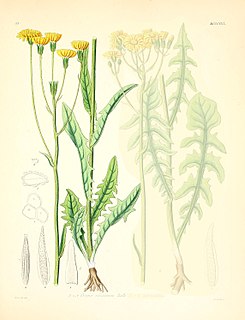
Crepis nicaeensis is a European species of flowering plant in the daisy family with the common names French hawk's-beard and Turkish hawksbeard. It is widespread across much of Europe, as well as being sparingly naturalized in scattered locations in the United States and Canada.

Crepis rubra is a European species of flowering plant in the daisy family with the common name red hawksbeard or pink hawk's-beard. It is native to the eastern Mediterranean region and is widely cultivated as an ornamental. It became naturalized in a small region of the United States.

Hedypnois rhagadioloides, the Cretanweed or scaly hawkbit, is a species of plant in the dandelion tribe within the sunflower family. It is native to the Mediterranean Region and neighboring areas from Canary Islands to Iran, and naturalized in Australia and in parts of the Americas.
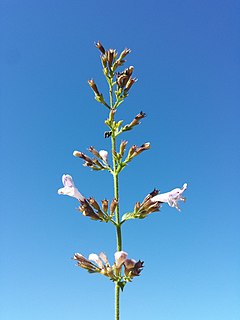
Clinopodium menthifolium, commonly known as the wood calamint or woodland calamint, is a species of flowering plant in the mint family, Lamiaceae. It is found throughout southern and central Europe from the United Kingdom and east as far as temperate parts of Asia, and as south as North Africa. It grows up to 1,700 m (5,600 ft) in elevation.

Libertia chilensis, synonym Libertia formosa, called the New Zealand satin flower, snowy mermaid, or Chilean-iris, is a species of flowering plant in the iris family, Iridaceae, native to the Juan Fernández Islands, central and southern Chile, and southern Argentina. It can also be found growing wild in the San Francisco Bay Area and San Bernardino County in California, where it is an introduced species. A rhizomatous evergreen perennial, it has gained the Royal Horticultural Society's Award of Garden Merit.
